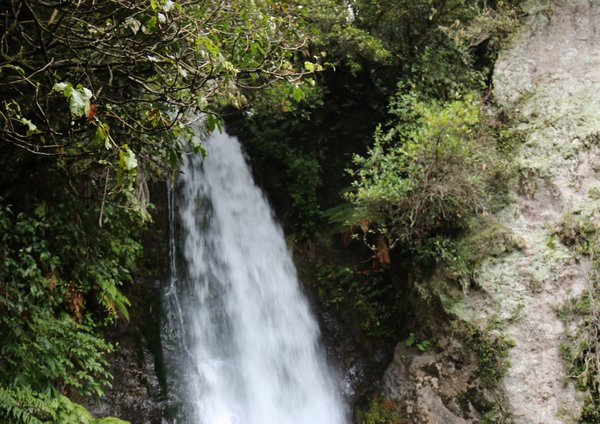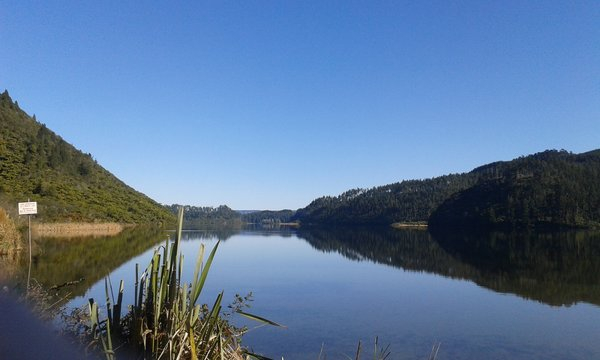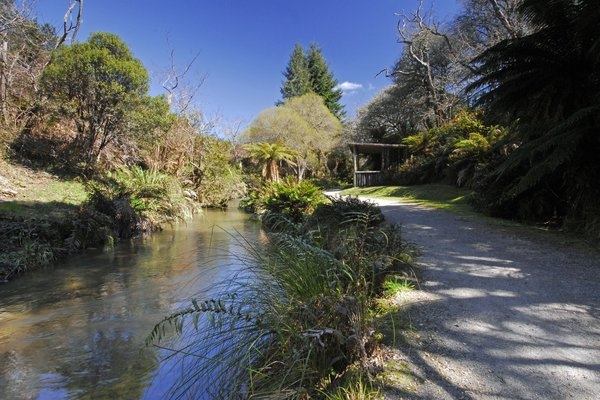The magnificent Wairere Falls located in historical Buried Village
The scenic waterfall trail at the Buried Village allows you to be immersed in the natural beauty of the area. The pristine water of the Te Wairoa stream offers a looking glass into the lives of the local rainbow trout and the surrounding native bush is diverse and beautiful.
Stroll past several historical sites before descending to the most breathtaking attraction of all; a 30 metre waterfall plunging over the Waitoharuru Cliffs.
Magnificent in its structure, the waterfall looks like a satin horse tail and there is nothing quite like standing at the base and feeling the soft spray of fresh water on your face.
The scenic waterfall trail is a peaceful 20-minute stroll. Although the steps to the base of the waterfall can be challenging, our visitors love to see the waterfall from this vantage point. However, if you feel like taking it easy, view the peaceful and green valley from the Waitoharuru Valley lookout. From here you can listen to the water gushing from the waterfall and see the stunning Lake Tarawera.
What’s behind the waterfall?
The emerald-green Lake Rotokakahi flows to Lake Tarawera via the Wairere Falls. Named by the Maori for its abundance of Kakahi shellfish, Lake Rotokakahi, or Green Lake, is one of three lakes that surround the Buried Village. The others are Lake Tikitapu (Blue Lake) and, of course, Lake Tarawera.
From above, Lake Rotokakahi has a distinct green colour due to its shallow water and sandy lake bed. It is privately owned by Tuhorangi descendants and they are the only people permitted to use it.
The Te Wairoa Falls are sheltered by cliffs formed by a crumbling lava dome. The cliffs protect the waterfall and help to keep its form and have been known to cause a few disruptions in the past, particularly in 1999 when a 50 ton boulder dislodged and rolled away. The infamous cave and the bridges and boardwalks built by the Smith brothers were destroyed. After two years of hard work, a new track was opened. The old track is now claimed by native foliage.
Are the Te Wairoa waters a reflection of life after devastation?
The destruction from the Mt Tarawera eruption in June, 1886 claimed the lives of many of Te Wairoa’s villagers. For many years after the eruption, the land was declared tapu and was prohibited to anyone who did not have special permission. Some of the first to return to the land after the tapu was lifted were Reg and Vi Smith who made the Buried Village the global attraction it is today.
It’s difficult to imagine the severity of the Mt Tarawera eruption when looking through the crisp water of the Te Wairoa stream.
Still and calm, the stream brings peace to the area. The short stretch of water attracts hundreds of spectacular Rainbow Trout. The fish consider the water to be ideal spawning conditions and provides them with a sanctuary because the stream is closed to fishing.
However, there is something about the waterfall that connects Mt Tarawera’s force with the abundance of life that has filled the area post-eruption.
As the water plummets to a depth of 30 metres, the roaring water represents the power of the eruption that the area is so well-known for.
Although the water falls with great speed, the stream below settles quickly. It is as if to suggest that once the conditions settle, destruction has the ability to promote life.
When you look around the Buried Village at the extensive vegetation, it makes you wonder whether the minerals brought to the soil after the eruption have anything to do with how beautiful Te Wairoa is today.
The Buried Village is more than a historical attraction
The Buried Village offers so much to its visitors. From an in-depth look into the history of the Mt Tarawera eruption to the wonders of New Zealand’s nature, the Buried Village has it all.
The waterfall, protected by its surrounding cliffs is an attraction in its own right. Many head to the Buried Village unaware that they will be given the opportunity to witness the beauty that the Te Wairoa waterfall delivers.
The only way to see the waterfall is through the Buried Village’s walkways and it is well worth the visit. So bring your walking shoes, wander through native surroundings, and experience the way nature can form beauty from even the most tragic events.











Connect with Us
Facebook YouTube Instagram Tripadvisor Blog Email